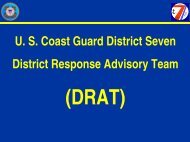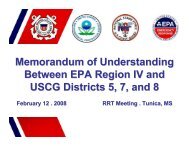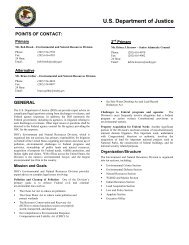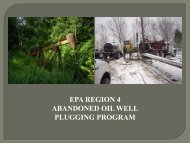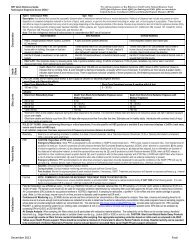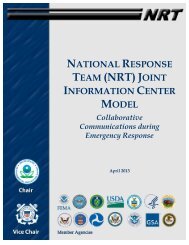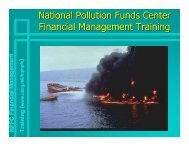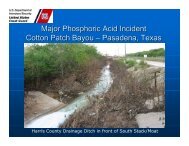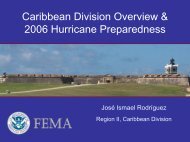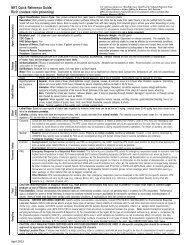USE OF DISPERSANTS - U.S. National Response Team (NRT)
USE OF DISPERSANTS - U.S. National Response Team (NRT)
USE OF DISPERSANTS - U.S. National Response Team (NRT)
- No tags were found...
You also want an ePaper? Increase the reach of your titles
YUMPU automatically turns print PDFs into web optimized ePapers that Google loves.
1. Is The Product Dispersible?DISPERSANT <strong>USE</strong> DECISION ELEMENTSThis question will be much easier to answer if responders know specifically what product was spilled.Dispersability will be affected by several factors. Firstly, the API Gravity(or density) of the oil must beconsidered. Generally, if API Gravity is 17 or above, then the oil may be dispersible. Oil or productswith an API Gravity above 45 are dispersible; however, because they evaporate rapidly they are generallynot dispersed. One must be aware, however, if 20,000 bbls of an oil with an API of 45 is spilled, 66%may evaporate; but there is still about 7,000 bbls that could affect sensitive environments.Viscosity of the oil will also impact its dispersability. Generally, an oil must have a viscosity of less than5,000- 10,000 centistokes to be effectively dispersed.Weathering of the oil will also significantly affect its dispersability. Finally, emulsification (orincorporation of water into the oil) will also affect dispersability. Predictions on the weathering andemulsification of an oil may be made with the NOAA "ADIOS" model. Caution in interpreting theresults needs to be exercised. The ability of the ADIOS model to predict viscosity is very unreliable forthe great majority of oils in the ADIOS database because of the lack of data on emulsification.In summary, an oil generally will be dispersible if:- API Gravity is more than 17;- Pour point is less than 10 F (5.5 C) below ambient temperature; and- Viscosity is less than 10,000 centistokes.Tables 1 and 2 may also prove helpful in determining an oil's dispersability.2. Are The Environmental Benefits Of Dispersing The Oil Likely To Outweigh Those OfNot Dispersing The Oil?This is perhaps the most difficult question to be answered in the dispersant-use decision-making process.Further information on weighing the environmental advantages versus disadvantages of using oil spilldispersants is available in Appendix V: "Biological Assessment of Dispersant Toxicity".3. Is The Chosen Dispersant likely To Be Effective?The following factors may affect the effectiveness of any given dispersant:- effectiveness of dispersant application to the oil;- dispersant-to-oil application ratio;- oil slick thickness;- distribution of oil slick on the water;- droplet size distribution in aerial spray;- oil viscosity;- energy input;- suspended particles in water (sedimentation);- weathering of oil;- emulsification (formation of mousse);- oil composition;



